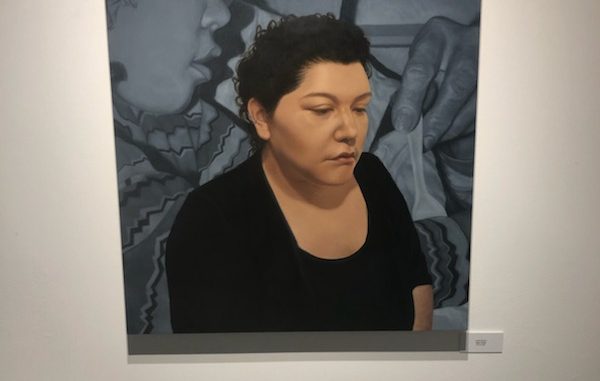
Erin Spicer, Staff Writer
The Martin-Mullen Art Gallery in the Fine Arts building is currently presenting “The Land on Which We Gather” art exhibition. The exhibition features the artwork of indigenous peoples from across the country. There are over 40 pieces displayed, including sculptures, mixed media sculpture, photography, beadwork, watercolor, oil, and acrylic paintings. There is also a virtual reality experience which gives a detailed history of indigenous culture in upstate New York and describes the lasting impact that the colonization of the Americas had on this culture.
This exhibition was funded by Jean Parish, an honorary faculty member of SUNY Oneonta, and supported through the cooperation of the Iroquois Indian Museum in Howe Cave, NY. During the opening reception on Thursday, September 5, artist Beatrice Glow and Lenape culture bearer Brent Stonefish gave an introduction and guidance through the exhibition.
Some of the featured artists include Glow and Alexander Giradeau, both whom displayed a collection of still, digital prints. The overall theme of the prints combined the restless and modern energy of a city with the serene and traditional aesthetic of indigenous culture. Looking at the prints brought the struggle between western and indigenous culture to mind. Many images displayed a post-apocalyptic city overgrown with greenery with flashing neon signs and skyscrapers contrasting with an image of an indigenous man or symbols such as a headdress or an arrowhead.
Another artist, Eris Gansworth, displayed several gouache paintings. Gouache paintings are created using opaque watercolors and a binding agent, usually gum. His collection featured similar themes to Glow and Giradeau, however his style utilized a brighter color palette and contained more abstract elements. Gansworth’s paintings displayed a lot of split images—western culture on one side, indigenous culture on the other. Surrounding these split images were beautiful abstract boarders that combined elements of both indigenous and western culture.
Tom Huff displayed a stone carving made from pink Colorado alabaster. The sculpture was of an indigenous woman sitting cross-legged, her arms held out in front of her as if cradling a child, and on her left knee, a child’s handprint is imprinted in bright red. I thought that this sculpture was very beautiful and nurturing and struck me as very traditional. Like most of the artists featured in this exhibition, Huff’s artwork has been described as capturing the attitude of Native Americans today.
It was very rewarding to take some time and walk through this exhibit, especially because of the close ties SUNY Oneonta shares with indigenous culture. The name of the town was given by the Iroquois peoples; they called this land “Ononta” which means mountain. Indigenous peoples are responsible for many of the names of regions in upstate New York and other areas of the country. It is easy to forget the history behind where we live and work everyday; this exhibition implores us to remember and reflect on this history.
On a table between two exhibits was a stack of books with more information on indigenous culture, the experience of indigenous people in today’s society, and the history of indigenous culture. I thought this was a really nice element to the exhibition because I found myself with a lot of questions after walking through the gallery. The gallery is open Monday through Friday between 11 a.m. and 5 p.m. and the exhibition will be available to the public until October 18.
Leave a Reply